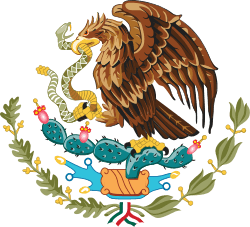Cuba–Mexico relations
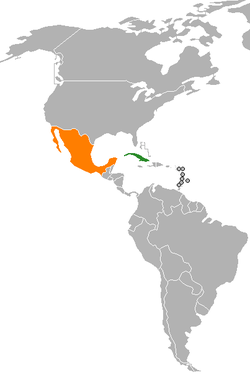 |
|
Cuba |
Mexico |
|---|---|
Cuba–Mexico relations are the diplomatic and bilateral relations between the Republic of Cuba and the United Mexican States. Both nations are members of the Association of Caribbean States, Latin American Integration Association, Organization of American States, Organization of Ibero-American States, Rio Group and the United Nations.
American and Soviet Influence on Mexican–Cuban Relations
The most important aspect of Mexican–Cuban relations is the influence of the United States and the Soviet Union. Throughout the 20th century, the two superpowers exerted control over the Latin American region and, as time progressed further in the Cold War, how each country treated the other profoundly affected how they would react. Mexico especially had to be cautious not to anger the United States when interacting with Cuba or the Soviet Union, making the relations more complicated than just two countries interacting.
For example, as the Cold War began and there were rising tensions between the United States and the Soviet Union, Mexico had to be careful of how its relations with each country could affect the other country's perception of Mexico. The United States had a Good Neighbor Policy towards countries like Mexico who were on the fence as to whether or not they should support the US or the USSR.[1] Since the United States feared neutrality of countries over anything else, as neutrality can turn into communism later, they pushed nations like Mexico to side with the US.[1] Later, President Kennedy would strengthen the Good Neighbor Policy by implementing his Alliance for Progress program, which helped Latin American countries with "economic growth and development."[2] With increased support from the US to push Latin American countries like Mexico towards democracy and away from countries like the USSR and Cuba, Mexico was put into a difficult situation. This American influence would put a strain on Mexico whenever they wanted to have positive relations towards Cuba, as it could have negative repercussions from Mexico's powerful neighbor.
The Soviet Union also affected the relations between Mexico and Cuba. The USSR had a large influence on Cuba already, which caused the relationship between Cuba and the United States to be problematic and contentious.[3] Cuba's revolution would not have been as successful as it was without the Soviet support they received, making them in debt to the USSR.[4] Mexico had to be careful when dealing with either Cuba or the USSR because of the problems that would cause in Mexican–American relations.
Throughout this article, the importance of the United States and the USSR in these relations will be discussed since it had a large impact on the relations between Mexico and Cuba. Especially during the Cold War era, the US believed that their relations with Mexico should help dictate, to an extent, how Mexico could treat Cuba and how public or private they needed to be with opinions towards Cuba.
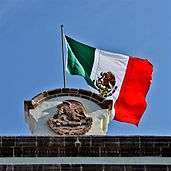
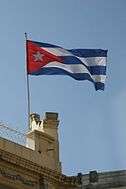
Early Relations Prior to the Cuban Revolution (1902–1959)
Background on Cuban Independence
After the Spanish–American War, the United States gained control of Cuba and slowly gave the country its independence in a limited form.[5] Under the Platt Amendment, the country was given independence with a few conditions.
Cubans Fleeing Political Persecution to Mexico
After Cuban independence, Mexico became an important country that Cubans would flee to when escaping political persecution, including notable Cubans like Fidel Castro who fled to Mexico from the Batista regime.[6] Mexico would later become the site from which Castro, Ernesto "Che" Guevara, and others started their trek back to Cuba to overthrow the Batista regime.[6] With Mexico as a location for Cubans to go to when they had problems with their native country, this created a Cuban population within Mexico, which made Mexico more involved in how it treated Cuba in the future.
Mexico's Role in the Cuban Revolution
Since Mexico became a refuge for Cubans exiled from Cuba, it also became a starting point for Cubans to revolt back home. After meeting in Mexico, Fidel Castro and Ernesto "Che" Guevara began to plan a guerilla war against the Batista regime in Cuba to take back Cuba for the people.[7] This movement became known as the "26th of July Movement," which began when Castro and Che entered Cuba in 1956 to overthrow dictator Batista, who ultimately fled the country in 1959.[6]:2 Mexico was a prime launching point for their boat since it was much easier to successfully get to Cuba from Mexico than if they had started from another country. Mexico gave Castro the advantage to plan out and launch the movement without the backlash that other countries, who supported the Batista regime, may have given him. On a final note, the Cuban government was backed by the American government at the time, so any movement against Cuba was also against the US, starting the bad relations between the US and Cuba as soon as Castro was victorious, which also showed Mexico that they needed to understand the need to be cautious with their Cuban relations from now on.[8]
Cold War Relations (1959–1991)
Cuba's Expulsion from the Organization of American States
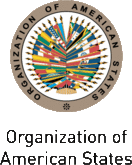
The Organization of American States (OAS) was an organization formed after World War II in 1948 to help "settle inter-American (hemisphere) disputes."[9] In 1962, Cuba was expelled from OAS.[10] Mexico was "the only Latin American country to maintain diplomatic ties with Cuba throughout the Cold War."[11] This demonstrated Mexico's dedication to keeping ties with Cuba, even when they had to consider how other countries could react.
Mexico Spying on Cuba for the United States but also Supporting Havana
The Mexican government had to be cautious with how it conducted its foreign policy. Even though it came out later that Mexico supported Havana, they also spied on Cuba for the United States, to help maintain good relations with the US.[12] They also had relations with the USSR and traded with Red China, but kept these interactions at a minimum so that the US would not know.[12] Mexico realized that supporting the United States publicly was important, but that individuals within their country were also interested in other foreign policies and relations. Thus, Mexico kept both private and public relations with various countries, depending on how the United States would react to each particular relation. Their biggest priority was to continue to have positive relations with their powerful neighbor, because opposing the US during this time period of the Cold War could have been a very bad decision for the Mexican government.
Increases in Mexican Leftist Propaganda and the Mexican Communist Party
After the Cuban Revolution, there was an increase in "leftist revolutionary propaganda" in Mexico.[13] Some believed that the Cuban Revolution could be seen as a reflection of the Mexican Revolution decades earlier and they became intrigued by the situation in Cuba.[13] Although it would have been difficult for Mexico to outright support the revolution, because of the United States' reaction, many Mexican citizens showed their support through art, music, and other propaganda.[13] After the Cuban Revolution, some Mexicans felt more connected with the socialist country, seeing their struggles for freedom similar to what the Mexican people had endured earlier in the 20th century.
One of these groups in Mexico dedicated to portraying leftist propaganda was the Taller de Gráfica Popular (TGP).[14] The TGP was a collective of artists who expressed Mexican culture, especially dealing with social issues in Mexico from the Revolution and later on in the century, through various art forms, like murals and prints.[15] This group was seen as having some more radical opinions, especially with their aligning with the leftist views in Mexico.[14] They would portray how they viewed ideas like the Mexican Revolution and the current issues in Mexico, which was important to the Mexican people. The Mexican government had been trying to limit the amount of leftist public opinions in the country, so this artistic group was not something that the Mexican government would have favored. The TGP had to be careful so that the artists did not do something too extreme that would cause the government to get involved. Overall though, the TGP helped spread their views and displayed to Mexico, and countries abroad, that there were leftist political opinions in Mexico and that the Mexican people thought about their revolutionary ideals still, decades after the Mexican Revolution.
There was also a Mexican Communist Party that was allowed to operate during the Cold War. More likely to support causes in Cuba and the USSR, the Mexican government had to be careful with how they treated the party. Disbanding them could cause a backlash among Mexican citizens, but allowing it to grow could anger the United States. The Communist Party, therefore, was allowed "to operate, but (the Mexican government) harassed, surveilled, jailed, and disappeared its leaders."[12] Groups like the Communist Party in Mexico demonstrated open support for countries like Cuba within Mexican borders but the government's treatment of the party was chosen especially to show loyalty to the United States.[12]
Post-Cold War to Present Relations (1991–2013)
Strains in the Mexican–Cuban Relationship
Mexico Recalls Havana Ambassador in 1998
In 1998, Cuban leader Fidel Castro made a comment that Mexican children recognize Mickey Mouse but do not know important individuals in Mexico's own history.[10] Mexico and Cuba had relatively good relations up until that point, but this comment offended the Mexican government enough that they withdrew their ambassador from Havana.[10] This event caused problems with the relations between Cuba and Mexico and would be the first in a line of events in recent years that would cause strains in their relationship.
United Nations Summit in Mexico in 2002

Another diplomatic issue occurred in 2002 when Vicente Fox, Mexico's pro-American president, allegedly "forced (Fidel Castro) to leave a United Nations summit in Mexico so that he would not cross paths with (US) President Bush."[16] Fox also asked Castro not to say anything that could be seen as "criticiz[ing] the United States."[17] To prove that it was forced, Castro produced a recording of his and Fox's conversation.[18] This strain would continue between Cuba and Mexico since Fidel Castro believed Mexico was "too closely aligned with Washington," especially since the US still did not have diplomatic relations with Cuba.[18]
Mexico Votes in Favor of UN Resolutions against Cuba's Human Rights Problems
In 2002, Mexican President Fox, "instructed the Mexican delegation to vote in favor of the UN resolution to criticize Cuba's human right's situation."[19] This was a major shift from prior relations, where Mexico always supported Cuba or chose to abstain from voting. Also, Fox replaced the Cuban ambassador, which led to some distrust from Havana towards President Fox.[19]
In 2004, Mexico's vote on a similar resolution became the deciding vote in a 22–21 vote against Cuba and its human rights issues.[19] Castro criticized Mexico since the country also had human rights violations, calling Mexico and other Latin American countries, "‘a herd of hypocrites.'"[19] Also in 2004, President Fox, "recalled the Mexican ambassador to Cuba" for a brief period of time, further straining relations.[11]
Improvements in the Mexican–Cuban Relationship

Mexican President visits Havana in 2012
Mexican President Felipe Calderon visited Havana in 2012 to help improve relations with Cuba.[20] Calderon's visit with current Cuban leader Raul Castro, brother of Fidel Castro, helped improve relations since the recent issues in the Mexican–Cuban relationship.[20] For more details on this visit, watch this link: https://www.youtube.com/watch?v=yphv8zsV6L4 [21]
Foreign Minister from Mexico Visits Cuba in 2013
Jose Antonio Meade of Mexico visited Cuba in September 2013 to further the improvements in Mexican–Cuban relations.[11] Many topics, including "trade and investment, as well as matters such as "‘tourism, migration, cooperation, education, culture, health [and] energy'" were discussed between officials from both countries.[11] Visits like this one and the President Calderon 2012 visit have been improving the problematic relations of the past few years.
State visits
Presidential visits from Cuba to Mexico[22][23][24][25]
- President Fidel Castro (1960, 1979, 1981, 1988, 1991, 1994, 2000, 2002)
- President Raúl Castro (2010, 2015)
Presidential visits from Mexico to Cuba[26][27][28][29][30]
- President Luis Echeverría (1975)
- President José López Portillo (1980)
- President Miguel de la Madrid Hurtado (1986)
- President Carlos Salinas de Gortari (1994)
- President Ernesto Zedillo (1999)
- President Vicente Fox (2002)
- President Felipe Calderón (2012)
- President Enrique Peña Nieto (2014, June an November 2016)
Resident diplomatic missions
- Cuba has an embassy in Mexico City[31] and consulates-general in Mérida, Monterrey, and Veracruz City and a consular office in Cancún.[32]
- Mexico has an embassy in Havana.[33]
See also
References
- 1 2 Joseph & Spenser (2008), p. 171
- ↑ Kennedy (2012)
- ↑ Joseph & Spenser (2008), p. 97
- ↑ Domínguez & Lindau (1984)
- ↑ Paterson et al., American Foreign Relations, Volume 2: A History (Boston: Wadsworth, Cengage Learning, 2010), 43.
- 1 2 3 "Cuba Overview." Congressional Digest 92, no. 7 (September 2013): 2–32. Academic Search Premier, (accessed November 3, 2013). .
- ↑ Richard Corliss and James Poniewozik. "Fateful Meetings." Time Vol. 161, No. 13 (March 31, 2003): A14. Academic Search Premier, (accessed November 3, 2013). .
- ↑ Strayer & Reilly (2009), p. 661
- ↑ Best et al. (2004), p. 381
- 1 2 3 Andrew Cawthorne (December 11, 1998). "Cuba tries to defuse spat with Mexico over Castro". Cubanet. Retrieved November 3, 2013.
- 1 2 3 4 "Mexican Foreign Minister Visits Cuba". Americas Quarterly. September 12, 2013. Retrieved November 3, 2013.
- 1 2 3 4 Joseph & Spenser (2008), p. 67
- 1 2 3 Kennedy, "Mexican Leftist Revolutionary Propaganda of the 1960s" (paper presented at the Rocky Mountain Council for Latin American Studies, Santa Fe, New Mexico, April 3–6, 2013).
- 1 2 Kevin McCloskey, "TGP: A Mexico City Pilgrimage," last modified April 2009, http://commonsense2.com/2009/04/americas-hidden-history/tgp-a-mexico-city-pilgrimage-draft.
- ↑ Cameron (1999), p. 353
- ↑ "Mexico's Fox apologises to Castro". BBC News. April 25, 2002. Retrieved November 3, 2013.
- ↑ Covarrubias (2013)
- 1 2 Marc Lacey (December 11, 2009). "Top diplomats of Cuba and Mexico meet". New York Times. Retrieved November 3, 2013.
- 1 2 3 4 Lindsay Thomas (July 30, 2004). "Mexico and Cuba welcome back ambassadors". Council on Hemispheric Affairs. Retrieved November 3, 2013.
- 1 2 "Mexico's President Calderon Pays First Official Visit to Cuba". Los Angeles Times. April 11, 2012. Retrieved November 3, 2013.
- ↑ Prensa Latina, "Felipe Calderon, Mexican President, Visits Cuba," https://www.youtube.com/watch?v=yphv8zsV6L4.
- ↑ History of diplomatic relations between Mexico and Cuba (in Spanish)
- ↑ Cronología: Relación México-Cuba, llena de altibajos (in Spanish)
- ↑ Un presidente cubano en México tras 8 años del "comes y te vas" de Fox (in Spanish)
- ↑ Castro: “La relación especial entre Cuba y México avanza” (in Spanish)
- ↑ IX Cumbre Iberoamericana en La Habana, Cuba (in Spanish)
- ↑ Viajes realizados al extranjero por el ciudadano Vicente Fox Quesada (in Spanish)
- ↑ México y Cuba se reacercan tras la visita del presidente Calderón (in Spanish)
- ↑ LLegó a La Habana el presidente mexicano Enrique Peña Nieto (in Spanish)
- ↑ En homenaje a Fidel, Peña refrenda amistad de México con Cuba (in Spanish)
- ↑ Embassy of Cuba in Mexico City (in Spanish)
- ↑ Cuban Ministry of Foreign Affairs: Mexico (in Spanish)
- ↑ Embassy of Mexico in Havana (in Spanish)
Bibliography
- Best, Antony; Hanhimaki, Jussi; Maiolo, Joseph A.; Schulze, Kirsten E. (2004). International History of the Twentieth Century and Beyond. London: Routledge.
- Cameron, Alison (1999). "Buenos Vecinos: African–American printmaking and the Taller de Gráfica Popular". Print Quarterly. 16: 353–367. JSTOR 41824990.
- Covarrubias, Ana (2006). "Cuba and Haiti in Mexico's foreign policy". International Journal. 61 (3): 661–676. JSTOR 40204196.
- Domínguez, Jorge I.; Lindau, Juan (1984). "The primacy of politics: comparing the foreign rolicies of Cuba and Mexico". International Political Science Review. 5 (1): 75–101. JSTOR 1600959.
- Joseph, Gilbert M.; Spenser, Daniela (2008). In from the Cold: Latin America's New Encounter with the Cold War. Durham, NC: Duke University Press.
- Kennedy, Courtney Brianne (2012). Vivas for Kennedy: John F. Kennedy's 1962 Presidential Visit to Mexico City (Master's thesis). University of Texas at Dallas.
- Strayer, Robert W.; Reilly, Kevin (2009). Ways of the World: a Brief Global History. Boston, MA: Bedford/St. Martin's.

